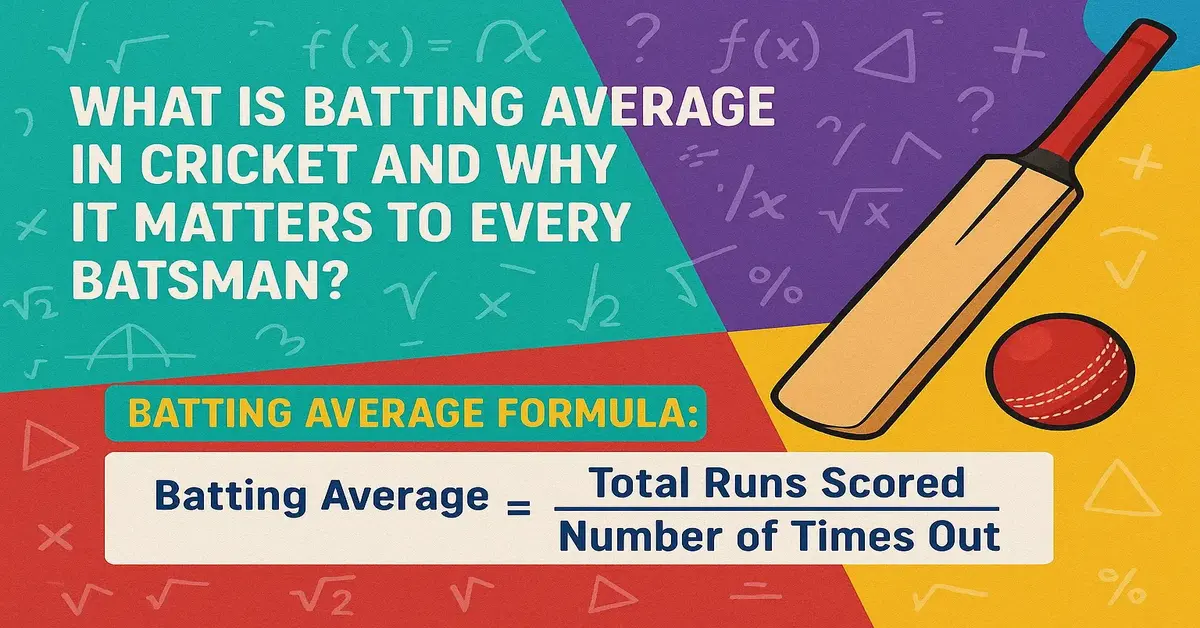What is Batting Average in Cricket and Why It Matters to Every Batsman?
In the world of cricket, batting average is one of the most important metrics used to measure a batter’s performance and consistency. Whether you’re comparing legends like Virat Kohli, Steve Smith, or newcomers like Shubman Gill, the batting average in cricket provides a strong indication of how effective and reliable a batter is.
What is Batting Average in Cricket?
Batting Average is calculated by dividing a batter’s total runs scored by the number of times they have been dismissed (i.e., got out).
How to Calculate Batting Average in Cricket?
Batting Average Formula :
🔹 Batting Average = Total Runs Scored / Number of Times Out
So if a batter has scored 5,000 runs and has been dismissed 100 times, their average would be 50.00.
This stat is not affected by the number of matches played or innings batted, but rather how consistently a player scores runs before getting out.
Use below Batting Average Calculator to calculate averages of any batsman.
🏏 Batting Average Calculator
Why is Batting Average So Important?
- Consistency Indicator: A higher average means the player consistently contributes runs to the team.
- Format Insights: In Tests, a high average indicates solid technique and patience. In ODIs and T20s, it often reflects reliability under pressure.
- Comparing Legends: It’s used to judge greatness over eras — for instance, Don Bradman’s average of 99.94 remains untouchable.
- Fantasy Leagues & Analysis: Batting average is a key stat in performance-based fantasy games and match predictions.
Top 5 Players with the Highest Batting Averages in International Cricket (As of 2025)
Here are five batters with the highest career batting averages in international cricket (minimum qualification applied):
| Player | Format | Matches | Runs | Batting Average |
|---|---|---|---|---|
| Sir Don Bradman | Test | 52 | 6,996 | 99.94 |
| Babar Azam | ODI | 117 | 5,800+ | 55.17 |
| Virat Kohli | ODI | 292 | 13,800+ | 57.9 |
| Shubnam Gill | ODI | 55+ | 2,200+ | 59.04 |
| Steve Smith | Test | 105+ | 9,000+ | 56.74 |
Batting Average in Different Formats
- Test Cricket: Averages above 50 are considered elite.
- ODIs: 45+ is great, 50+ is excellent.
- T20Is: Average isn’t as crucial as strike rate, but 35+ is strong.
FAQs: Batting Average in Cricket
Q1. What is considered a good batting average in cricket?
A good average in Test cricket is 45+, in ODIs it’s 40+, and in T20Is it’s 30+ depending on the role.
Q2. Who has the highest batting average in cricket history?
Sir Donald Bradman holds the record with a Test average of 99.94, the highest in cricket history.
Q3. Does “Not Out” affect batting average?
Yes, if a batter remains “not out,” the innings doesn’t count as a dismissal, which boosts the average.
Q4. Is batting average more important than strike rate?
In Tests, average matters more. In T20s, strike rate is often more crucial. In ODIs, both are important.
Q5. How is average different from total runs?
Total runs show volume of runs, while average reflects efficiency in scoring those runs.
Final Words
Whether you’re a die-hard cricket fan or a casual viewer, understanding batting average can help you appreciate the brilliance of players like Virat Kohli, Babar Azam, and Steve Smith. It’s not just about how many runs they score, but how consistently they do it — that’s where batting average becomes king.

